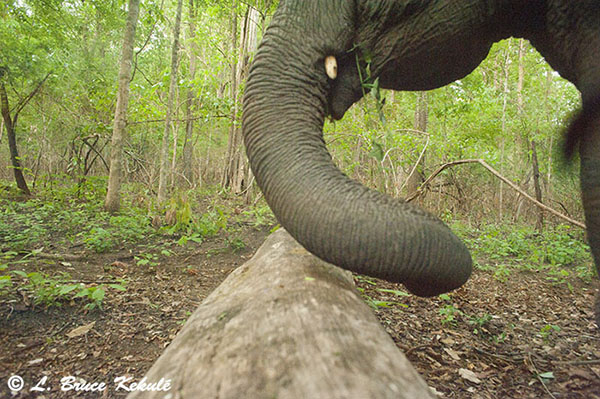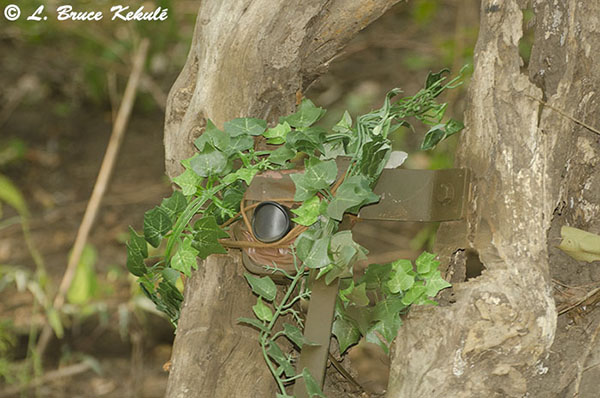Posts Tagged ‘feline’
The Asian Leopard – Thailand’s 2nd largest wild cat…!
This film is a culmination of videos and still photographs of leopards captured by video and DSLR camera traps in the ‘Western Forest Complex’ of Thailand. The first black cat video was taken just a few months ago. Enjoy..!
Nikon D90 catches a rare ‘clouded leopard’…!
One of the most beautiful of all the Asian wild cats
Once upon a time, the clouded leopard (Neofelis nebulosa) was found all over Thailand when some 75 percent of the country was covered in forest. At the end of WWII, the human population really began to explode and these magnificent biospheres were cut down for agriculture and settlement taking all the natural resources in its wake. Modern transportation, weapons and logging on a grand scale began to quickly shrink this once remarkable heritage.
Barely 20 percent forest cover is now surviving in an ever-shrinking wilderness. The clouded leopard has been exterminated primarily for its pelt and now survives in all but a few protected areas throughout the Kingdom. It is one of the most beautiful marked creatures in the world. The marbled cat (Pardofelis marmorata), another wild feline is similar in coat pattern but smaller in size. Both of these cats have become extremely rare throughout their range.
In July of this year, I decided to make a trip down to Khlong Saeng Wildlife Sanctuary in southern Thailand in conjunction with Greg McCann and Habitat I.D. (NGO to monitor wildlife in Southeast Asia) to set some camera traps in the moist evergreen forest to see what was still thriving here. Three years ago, I did a camera trap and photographic survey of this protected area and got a marbled cat up on a ridgeline in the interior, plus a clouded leopard in a cave entrance at another location. I knew there was still good possibilities that I would get these cats again.
I decided to set my Nikon D90 DSLR trail cam along with a couple Bushnell Trophy Cams at this same location. Unfortunately, the hard-wired slave flashes were not working due to wiring problems and so left the cam with its single hot-shoe mounted Nikon SB-400 flash. I knew then if the cam caught any creature, I would get images with ‘eye-shine’ but decided to leave it anyway.
I have just returned from Khlong Saeng to collect the data from these cams. Imagine my surprise to see a clouded leopard on the D90’s card. It was an absolute joy to see this cat had passed the cam and even though the ‘eye-shine’ was there, the markings and beauty of this carnivore is truly remarkable. I have pulled the D90 and put a Canon 400D with three Nikon SB-28 slaves which was working very well when I left it. The Bushnell cams also recorded many other species and I will be doing a video post soon. Enjoy…!
Nikon D700 catches a male leopard on one paw…!
A big cat crossing the ‘tiger log’
Male leopard shot #1.
Male leopard on one paw….shot #2.
Male elephant – the flash destroyer.
Elephant back for more.
Banteng bull.
Evert year, forest fires occur in Thailand’s ‘Western Forest Complex’ during the dry season usually started by the human population living around the protected areas. Occasionally, lightning ignites fires but this natural phenomena, is less frequent. Stray cigarette butts also account for many fires. For the most part, local poachers start them to allow long distance spotlighting during the night. With the brush gone, they are able to see the reflection in the eyes distinctly (usually deer) with their headlamps.
Occasionally these fires are fierce and any camera trap left in the forest during this time will likely be destroyed. I always move my cams to evergreen forests from about February through to April that normally do not have fire, and this year was no different. But as soon as the first monsoon rains come in mid-April, the forest is safe once again for camera trapping.
With the first good rains through, I decided to setup my Nikon D700 back on the log. This time the cam is using a hardwired SSII sensor (Snapshotsniper.com) with a 10-meter cable setup in the tree stump apposite the cam. Also, a third flash was added and installed above the cam’s ‘elephant proof ‘ box. However, the ‘third flash’ is now history as a young tusker found it and turned it into rubble (below) but the cam, the sensor and two other flashes survived.
It was great to see this male leopard cross over the log. The first image is a good record shot but the second one is really something special catching this mature predator on one paw with the other three in mid-air. Also, the reproductive organ is sharp and just hanging there with its tail is balancing the big cat. He looks like he is winking at the cam. Once again, within two shots, the leopard turned his head to see what the flash was all about just like my tiger in late January 2014. The speed and reaction time of these felines is legendary and it doesn’t get any better…!
I also got the elephant that destroyed the third flash plus a banteng bull that stopped short but did not cross over. All in all, it was a great start to a new season at the ‘tiger log’. The full-frame D700 firing off a two-shot burst is in its element with a 28mm lens but now with only two flashes thanks to the forest giant. I have installed a 35mm lens this time to see what a tighter crop will do. Enjoy..!
Damaged SB-28 flash.
Nikon D700 setup on the log.
Hardwired external SSII (Snapshotsniper.com) sensor.
Hardwired Nikon SB-28 flash setup.
*****************************************
D700 settings: ƒ8 – 1/125 at ISO 400.
Edited in Adobe Camera Raw.
Leopard shot #1: full-frame.
Leopard shot #2: cropped.
Elephant and banteng bull: full-frame.
Leopards camera trapped on a kill in Huai Kha Khaeng Wildlife Sanctuary
Leopards at a sambar kill in Huai Kha Khaeng Wildlife Sanctuary, western Thailand. This rare camera trap photo was a complete surprise to see a yellow phase mother leopard and a young black cub. There are many black leopards in this protected area and it is a tribute to its status as a World Heritage Site.












